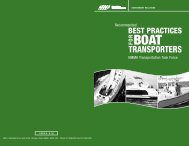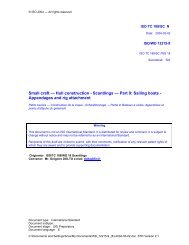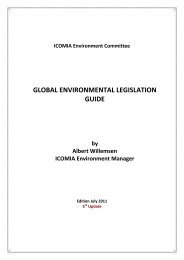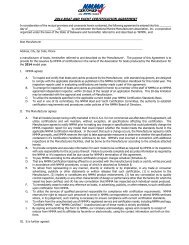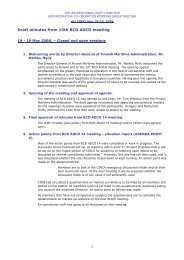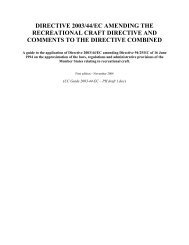Intellectual Property Protection and Enforcement Manual - Ipr-policy.eu
Intellectual Property Protection and Enforcement Manual - Ipr-policy.eu
Intellectual Property Protection and Enforcement Manual - Ipr-policy.eu
Create successful ePaper yourself
Turn your PDF publications into a flip-book with our unique Google optimized e-Paper software.
Br<strong>and</strong> <strong>Protection</strong> <strong>Manual</strong><br />
New Balance<br />
Headquartered in Boston, Massachusetts, New Balance is one of the world’s most wellknown<br />
<strong>and</strong> respected manufacturers of performance footwear <strong>and</strong> athletic apparel.<br />
The company employs more than 2,600 people around the globe <strong>and</strong> in 2005<br />
reported worldwide sales of $1.54 billion.<br />
New Balance’s success is closely tied to the integrity <strong>and</strong> visibility of its br<strong>and</strong>. This is true<br />
of most footwear <strong>and</strong> apparel companies: quality <strong>and</strong> fit make up the value proposition, but<br />
marketing, image, <strong>and</strong> identifiability often make the sale. This is why trademark infringement<br />
is a concern to companies like New Balance. According to Ed Haddad, vice president for<br />
intellectual property <strong>and</strong> licensed products at New Balance, footwear counterfeiters aren’t just<br />
making a fake product; they’re diluting the br<strong>and</strong>, damaging the company’s reputation, <strong>and</strong><br />
undermining the worldwide salability of the product.<br />
Most of New Balance’s products are manufactured along the Pacific Rim, specifically in<br />
China <strong>and</strong> Vietnam. These are also the largest black markets for counterfeit footwear, as well<br />
as the places where assistance from local <strong>and</strong> national authorities is least forthcoming. In<br />
addition, Far-East production makes it harder to monitor the flow of raw materials <strong>and</strong> to<br />
ensure the conduct of the company’s contract manufacturing facilities. In the late 1990s, for<br />
example, New Balance severed relations with a Pacific Rim manufacturer but subsequently<br />
discovered that the company was continuing to make <strong>and</strong> ship now-illegal products. This<br />
behavior is a real problem; however, fly-by-night factories <strong>and</strong> unreliable supply chain<br />
partners are the biggest challenge.<br />
Interestingly, many overseas consumers of counterfeit footwear know they are not purchasing<br />
the real thing. For them, value is tied to the image, not to the quality. For a fraction of the<br />
retail price, they’re happy to obtain the former <strong>and</strong> sacrifice the latter. This further complicates<br />
a company’s efforts to control counterfeiting, since awareness building at the consumer level<br />
is difficult <strong>and</strong> not always productive. Also, foreign patent <strong>and</strong> trademark offices are often lax<br />
about permitting the registration of nearly identical logos. The net effect is that even wellintended<br />
consumers can become black market buyers.<br />
Counterfeiting clearly costs New Balance money <strong>and</strong> market share. However, the damage in<br />
this context is relatively small since consumers of illegitimate products do not markedly reduce<br />
the pool of legitimate buyers. Legitimate buyers also covet the br<strong>and</strong>; but quality <strong>and</strong> fit—only<br />
available with the genuine article—are usually too important to settle for a knock-off. The real<br />
danger is erosion of br<strong>and</strong> impact—confusing <strong>and</strong> alienating consumers <strong>and</strong> retailers who can<br />
no longer tell what is real <strong>and</strong> what isn’t. Over time, of course, these problems become more<br />
income <strong>and</strong> share-related.<br />
Page 41



